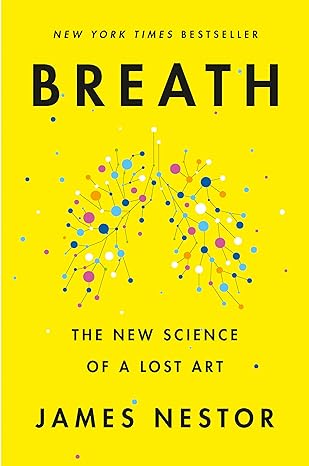Have you ever stopped to think about your breath? Breathing is one of those things we do unconsciously, without even giving it a second thought. After all, it's just a natural part of our autonomic nervous system, right? Well, it turns out that our breath is far more powerful than we might realize.
There's something called the mind-body-breath connection, and delving into this fascinating topic could unlock a world of transformation for your health and wellness.
The Mind Body Breath Connection
The mind-body-breath connection is centered around the idea that how we breathe affects not only our physical body but also our mental and emotional well-being.
Breathing is a fundamental aspect of our autonomic nervous system, often happening without conscious thought. Yet, the way we breathe can influence our stress levels, energy, and overall sense of well-being.
It's essential to understand that most of the time, we should be breathing through our nose rather than our mouth. Nasal breathing provides benefits such as filtering, moistening, warming, and slowing down the air before it reaches our lungs.
This, in turn, helps to promote a smoother exchange of respiratory gases and contributes to a sense of calmness in our body.
The Power of Nose Breathing
One essential practice to reconnect with the benefits of nasal breathing is to close your mouth. Yes, it's as simple as that!
By breathing through your nose, you can start to engage with your breath consciously and observe the changes in your body and mind. You might be surprised to discover that many people often resort to mouth breathing, unaware that they can achieve a greater sense of calmness and well-being by breathing through their nose.
So, let's clear something up about breathing through the mouth. While there are specific breathing exercises that may involve mouth breathing for particular reasons, the general principle is to prioritize nasal breathing.
By training ourselves to breathe through our nose, we can experience a profound shift in our overall well-being and discover that we often don't need to breathe as excessively as we thought.
The Practice of Breath Awareness & Mouth Taping
Developing a breath-focused practice starts with building awareness of your breathing patterns.
You can start by taking some time each day to sit quietly and pay attention to your breath. Close your mouth and focus on the sensation of air as it enters and leaves your body through your nose. Notice any changes in your body, your circulation, and your emotional state as you become more aware of your breath.
By practicing breath awareness, you can gain insights into your breathing habits throughout the day and learn to recognize when you're mouth breathing, which can be incredibly empowering.
At this point, some of you might be wondering about the practice of mouth taping. It's a simple and powerful technique that involves taping your mouth shut during sleep. While it may sound a bit unconventional, mouth taping can provide fantastic benefits. By ensuring nasal breathing during sleep, you can significantly improve your sleep quality, wake up feeling more refreshed, and enjoy improved overall health and well-being.
You can start by practicing mouth taping during the day to become comfortable with the sensation. And if you're open to the idea, try it at night for around 90 days to experience a reset that could positively impact your health and sleep patterns.
Once you become accustomed to nasal breathing during sleep, you may find that it becomes a comforting and enriching practice.
Breathing for Children
When it comes to teaching children about the benefits of proper breathing, it's never too early to start. As a parent, you can gently encourage your little ones to practice nasal breathing.
For example, if your child is sleeping with their mouth open, gently encourage them to close their lips to promote nasal breathing. As they grow, incorporating breath-focused practices such as mindful breathing and meditation can help them develop healthy breathing habits from an early age.
As your children learn the language of breath, they can gain valuable tools for managing stress and emotions, and lay the foundation for a lifetime of good health and well-being. Providing a supportive environment for young children to develop healthy breathing habits can set them on a path towards enhanced physical and mental health.
Connect with Breath Experts
While the practice of breath awareness and nasal breathing can bring about remarkable changes, it's essential to recognize the significance of seeking expert guidance.
Breathing is a fundamental yet potent aspect of our well-being, and getting it right can positively impact various areas of our health. If you're considering delving deeper into the world of breath coaching and practices, consider reaching out to a breath expert.
These professionals can help guide you through breath awareness and provide tailored advice to ensure that you're engaging with your breath in the best way for your individual needs.
One breath at a time, you can tap into the incredible power of your breath for improved health, in mind, body, and soul.
Embracing the Power of Your Breath
Now that you understand just how influential your breath can be, you are equipped to embark on a fascinating journey of discovery and transformation.
By acknowledging the mind-body-breath connection and adopting practices of breath awareness and nasal breathing, you can unlock the potential for heightened well-being and overall health.
Remember, it's never too late to start paying attention to your breath. Whether you're nurturing your own well-being or guiding your children towards a healthy respiratory practice, the benefits of conscious breathing are far-reaching and compelling. So, take a deep, intentional breath through your nose, and let the journey of breath awareness and well-being begin.
One fascinating resource is the book Breath by James Nestor, it was a Healthy Readers Book Club selection and everyone learned a lot.

Best Practices for Breathing Well
1. Start young: Introduce gentle mouth-closing techniques for infants to familiarize them with nasally breathing from an early age.
2. Close your mouth: Increase awareness by gently closing your mouth to encourage nasally breathing. This switch can help calm the body and improve respiratory efficiency.
3. Tape method: Sleep with a small strip of micropore nasal breathing tape across the lips to maintain nasal breathing during the night, ensuring deep and uninterrupted sleep.
4. Mindful breath observation: Spend time observing the air entering through your nose, allowing for a deeper understanding of your body's breathing patterns.
5. Seek expert guidance: Explore breathing practices cautiously and seek professional advice for tailored recommendations, especially when exploring advanced breathwork techniques to avoid adverse effects.
In this episode I chat with Adam Stanecki, The Breath Geek as he teaches us how to Breathe Different.


